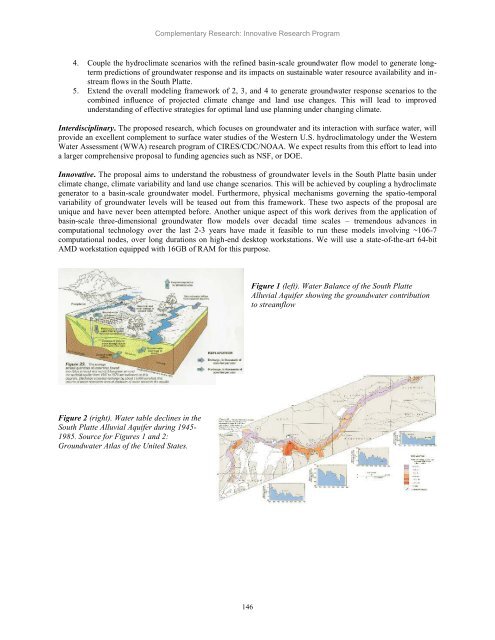Scientific Theme: Advanced Modeling and Observing Systems
Scientific Theme: Advanced Modeling and Observing Systems
Scientific Theme: Advanced Modeling and Observing Systems
You also want an ePaper? Increase the reach of your titles
YUMPU automatically turns print PDFs into web optimized ePapers that Google loves.
Complementary Research: Innovative Research Program<br />
4. Couple the hydroclimate scenarios with the refined basin-scale groundwater flow model to generate longterm<br />
predictions of groundwater response <strong>and</strong> its impacts on sustainable water resource availability <strong>and</strong> instream<br />
flows in the South Platte.<br />
5. Extend the overall modeling framework of 2, 3, <strong>and</strong> 4 to generate groundwater response scenarios to the<br />
combined influence of projected climate change <strong>and</strong> l<strong>and</strong> use changes. This will lead to improved<br />
underst<strong>and</strong>ing of effective strategies for optimal l<strong>and</strong> use planning under changing climate.<br />
Interdisciplinary. The proposed research, which focuses on groundwater <strong>and</strong> its interaction with surface water, will<br />
provide an excellent complement to surface water studies of the Western U.S. hydroclimatology under the Western<br />
Water Assessment (WWA) research program of CIRES/CDC/NOAA. We expect results from this effort to lead into<br />
a larger comprehensive proposal to funding agencies such as NSF, or DOE.<br />
Innovative. The proposal aims to underst<strong>and</strong> the robustness of groundwater levels in the South Platte basin under<br />
climate change, climate variability <strong>and</strong> l<strong>and</strong> use change scenarios. This will be achieved by coupling a hydroclimate<br />
generator to a basin-scale groundwater model. Furthermore, physical mechanisms governing the spatio-temporal<br />
variability of groundwater levels will be teased out from this framework. These two aspects of the proposal are<br />
unique <strong>and</strong> have never been attempted before. Another unique aspect of this work derives from the application of<br />
basin-scale three-dimensional groundwater flow models over decadal time scales – tremendous advances in<br />
computational technology over the last 2-3 years have made it feasible to run these models involving ~106-7<br />
computational nodes, over long durations on high-end desktop workstations. We will use a state-of-the-art 64-bit<br />
AMD workstation equipped with 16GB of RAM for this purpose.<br />
Figure 2 (right). Water table declines in the<br />
South Platte Alluvial Aquifer during 1945-<br />
1985. Source for Figures 1 <strong>and</strong> 2:<br />
Groundwater Atlas of the United States.<br />
146<br />
Figure 1 (left). Water Balance of the South Platte<br />
Alluvial Aquifer showing the groundwater contribution<br />
to streamflow
















